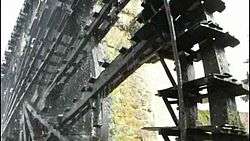Norias of Hama
Coordinates: 35°8′7″N 36°45′11″E / 35.13528°N 36.75306°E



The Norias of Hama (Arabic: نواعير حماة) are a number of norias ("wheels of pots") along the Orontes River in the city of Hama, Syria. Only seventeen of the original norias remain. They are mostly unused now and serve an aesthetic purpose. They were called "the most splendid norias ever constructed".[1] The norias of Hama were submitted as a tentative World Heritage Site by the Syrian Arab Republic in June 1999.[2]
History

The earliest evidence for norias in Hama suggests they were developed during the Byzantine era, although none of the norias in Hama today precede the Ayyubid period. However, a mosaic found at Apamea dating to 469 AD pictures a noria very similar to those at Hama, suggesting they may have earlier origins.[3] Now only 17 norias remain, unused.[4]
Description
A noria (Arabic: ناعورة, nā‘ūra) performs the function of moving water from a lower elevation to a higher elevation. In this it is similar to the saqiya and other pumps like the Persian wheel (Rahat in Urdu), but those are generally powered by other means or a combination, usually lifting water from a pond or well. Noria is similar to the modern hydraulic ram, which also uses the power of flowing water to pump some of the water out of the river.
Unlike the water wheels found in mills, a noria does not provide mechanical power to any other process. A few historical norias were hybrids, consisting of waterwheels assisted secondarily by animal power. A noria can raise water to a level that's less than its full height. The Hama noria is the largest in the world, with a diameter of about 20 meters.
The origin of this device is most likely is the Greek Byzantium. Many credible references can be found in medieval texts. Philo of Byzantium describes in Pneumatica a structure with similar functions. Hero of Alexandria in the 1st century B.C. tried a to make a distinction between a bucket-chain and wheel for raising water. However, it must be kept in mind that the principle of axial flow was well known in the Islamic world since 9th century when it was attested by the Banu Musa brothers who, in their Kitab al-hiyal (Book of Ingenious Devices) written in Baghdad in about 850 CE described a horizontal wheel placed in one of their fountains and driven from below by a number of vertical jets of water.
References
- ↑ Needham and Ronan, 1995, p.281.
- ↑ http://whc.unesco.org/en/tentativelists/1291
- ↑ Adriana De Miranda (2007). Water Architecture in the Lands of Syria: The Water-wheels. L'ERMA di BRETSCHNEIDER. pp. 53–. ISBN 978-88-8265-433-7. Retrieved 24 August 2012.
- ↑ Ring, Berney, Salkin, La Boda, Watson, and Schellinger, 1996, p.137-138.
Bibliography
- Ring, Trudy; Berney, K.A.; Salkin, Robert M.; La Boda, Sharon; Watson, Noelle; Schellinger, Paul (1996), International Dictionary of Historic Places: Middle East and Africa, Routledge, ISBN 1-884964-03-6.
- Needham, Joseph; Ronan, Colin A. (1995), The Shorter Science and Civilisation in China: Volume 5, Cambridge University Press, ISBN 0-521-46773-X.